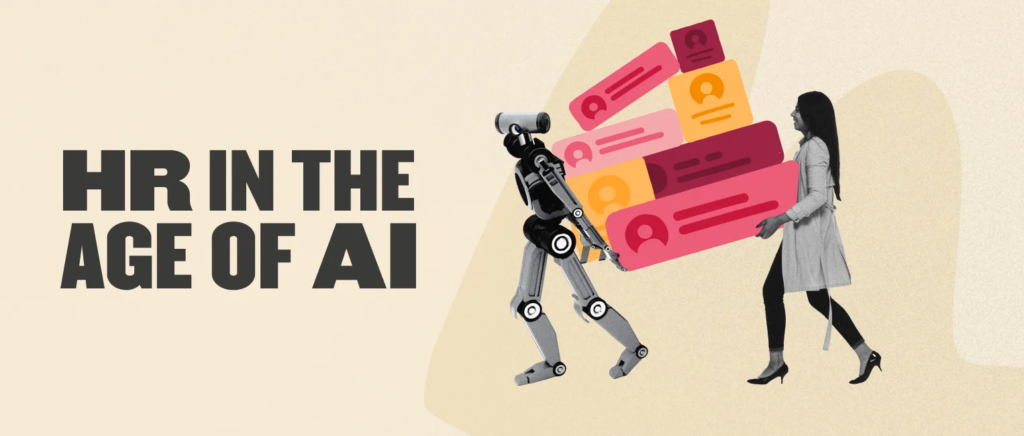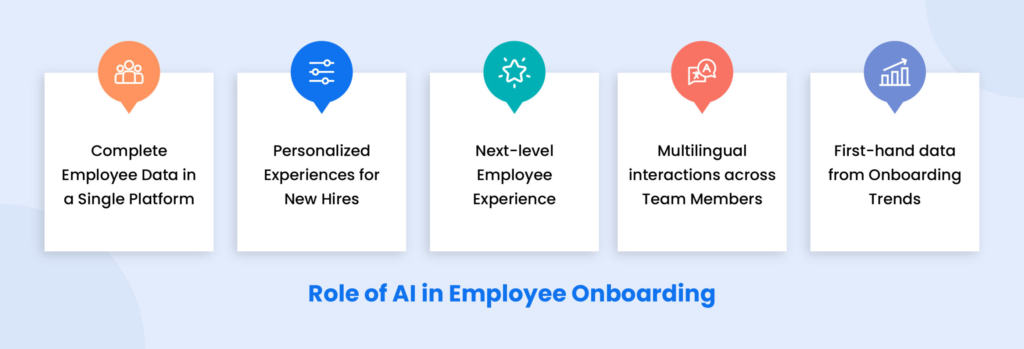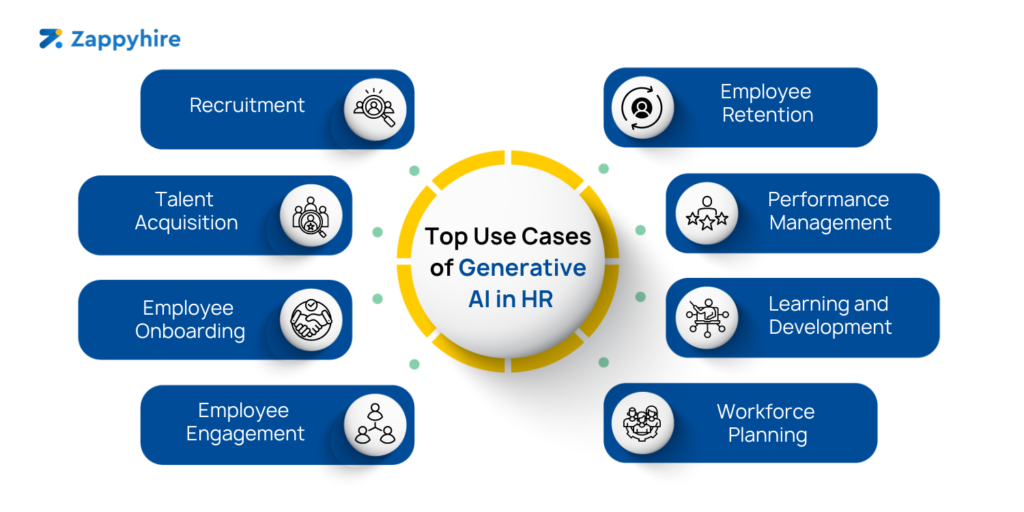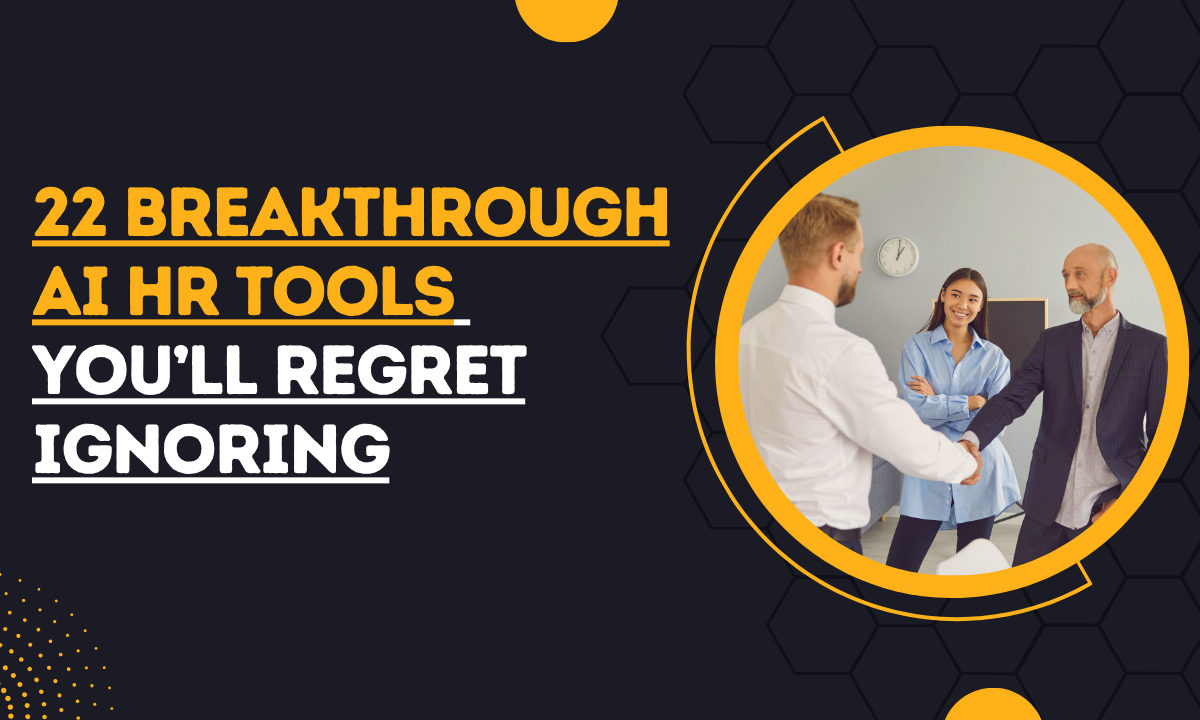22 Breakthrough AI HR Tools You’ll Regret Ignoring
AI HR tools are rapidly transforming how HR professionals work, from hiring the right talent to nurturing employee growth.
Artificial intelligence has fundamentally changed business operations, and human resources is no exception.
By automating repetitive tasks and providing predictive insights, these tools are helping HR teams operate smarter, faster, and more strategically.
If you’re not yet exploring these technologies, you might be leaving efficiency—and competitive advantage—on the table.
What AI Really Means for HR Today
Artificial Intelligence has moved from futuristic buzzword to practical business utility — and HR is no exception.
Jeanne Meister, the co-author of The Future Workplace Experience says “AI will augment HR and give HR time to work on more strategic business issues. The opportunity is to use AI to streamline HR manual processes”.
When you hear people talk about AI HR tools, what they’re really describing are systems that can think, learn, and act in ways once limited to human judgment.
But what does that look like inside a real workplace?
It means using data, algorithms, and automation to handle everything from recruitment to retention — while offering insights no spreadsheet could ever reveal.
The truth is simple: HR is no longer just about managing people. It’s about understanding them through intelligent data.
Understanding the Core AI Technologies in HR

Source: HiBob
Generative AI: The Creative Engine
Generative AI doesn’t just analyze — it creates.
In HR, this means auto-drafting job descriptions.
It also includes crafting interview questions aligned with company values, or even generating personalized performance goals.
Think of it as a tireless content partner that writes with precision and context.
Conversational AI: HR’s New Voice
Gone are the days when employees waited hours for an HR reply.
With conversational AI, chatbots and digital assistants can instantly answer policy questions.
They can even guide workers through processes, or collect feedback — all in natural language.
It’s not replacing HR; it’s scaling it.
Deep Learning: Finding Patterns Humans Miss
HR data is massive — from performance metrics to engagement surveys.
Deep learning algorithms sift through this complexity to find correlations no human could spot.
The result?
Personalized training recommendations, internal mobility suggestions, and smarter talent decisions based on skill patterns.
Intelligent Automation: Doing More with Less
Automation isn’t about cutting jobs; it’s about cutting inefficiency.
Payroll irregularities, benefits processing, and compliance checks can all be handled automatically.
interestingly, HR professionals are then free to focus on what machines can’t — empathy, culture, and strategy.
How AI Is Reinventing Recruitment
Is AI just hype when it comes to hiring?
Not anymore.
Recruitment has always been one of HR’s most time-consuming challenges.
Now, AI HR tools can manage almost the entire pipeline:
- Candidate sourcing: AI scours job boards, social platforms, and databases to identify ideal profiles.
- Screening and assessment: Algorithms evaluate skills, experience, and personality fit — minimizing unconscious bias.
- Interview preparation: Tools generate consistent interview questions and even analyze candidate tone or engagement.
- Chat-based engagement: 24/7 chatbots handle FAQs, schedule interviews, and keep candidates informed.
The result is faster hiring, better candidate experiences, and decisions rooted in data, not gut instinct.
From Offer Letter to Belonging: AI in Onboarding

Source: LeenaAI
Joining a new company can be overwhelming.
But AI is turning onboarding into a seamless digital journey.
Automated workflows handle document signing, policy distribution, and access setup.
Personalized welcome modules adjust to an employee’s department, location, and role.
Meanwhile, virtual assistants are always available to answer those first-week questions like “Where do I find the HR portal?” or “How do I apply for leave?”
For remote or hybrid teams, this consistency is invaluable.
Everyone gets the same quality of experience — no matter where they log in from.
Tailoring Talent Management with Precision
How well do you really know your employees?
Their hidden skills, aspirations, or readiness for leadership?
AI makes that visibility possible.
Building Smart Skill Maps
AI systems can track skills across departments, spotting overlaps, gaps, and potential future leaders.
Imagine having a live map of your organization’s capabilities, updated automatically as employees grow.
Personalized Growth Pathways
From recommending online courses to matching mentors, AI creates customized learning journeys.
Employees feel seen and supported — and engagement naturally rises.
Internal Mobility Made Easy
Instead of hiring externally, AI helps HR discover transferable skills within the company.
A marketer with strong data analysis skills, for example, might transition to a product analytics role.
The business saves time, and the employee finds renewed motivation.
Real-Time Performance Insights
Forget annual reviews that arrive too late to matter.
AI tools now provide ongoing feedback loops, tracking progress and flagging areas for coaching in real time.
Strategic Workforce Planning
Predictive analytics go a step further — forecasting who might leave, which skills will be in demand, and how to prepare for upcoming projects.
It’s HR as a strategic partner, not just an administrative function.
Enhancing the Employee Experience
Retention is the real win.
And AI is helping companies achieve it through personalization and proactive support.
Personalization is essentially the process of tailoring experiences to match an individual’s preferences, behavior, or needs.
Employees can now manage routine tasks — from benefits updates to payroll queries — without waiting in queues.
Chatbots and self-service systems simplify everyday interactions.
Meanwhile, advanced analytics quietly monitor engagement, flagging signs of burnout or disengagement long before they escalate.
Generative AI even allows employees to “talk” to HR policies conversationally, getting clear answers in plain English rather than combing through PDFs.
The HR experience begins to feel less bureaucratic and more human.
The Real Benefits of Using AI HR Tools
You don’t have to be a futurist to see the value here.
Organizations adopting AI in HR are already noticing measurable improvements:
- Speed: Recruiting, onboarding, and appraisals happen in a fraction of the time.
- Productivity: Teams can focus on strategy rather than admin.
- Fairness: AI-driven evaluations reduce bias in hiring and promotion.
- Satisfaction: Personalized employee interactions build stronger engagement.
- Insight: Data-backed recommendations lead to smarter HR decisions.
- Agility: Predictive planning helps businesses adapt before challenges appear.
AI HR tools aren’t abstract concepts anymore — they’re competitive advantages that shape how modern companies attract, grow, and retain talent.
Common Pitfalls — and How to Avoid Them
AI isn’t foolproof.
The smartest systems still depend on human oversight.
Here are the biggest traps HR leaders must watch for:
Data Privacy and Compliance
AI systems rely on sensitive employee information.
It’s essential to follow regional data laws (like GDPR) and maintain transparency about what’s being analyzed.
Algorithmic Bias
Bias doesn’t vanish just because a machine makes the decision.
Regular audits and diverse training datasets are critical for fairness.
Integration Challenges
Many companies struggle to connect new AI tools with legacy HR systems.
Proper change management and technical onboarding are essential.
Adoption Resistance
Employees might fear automation will replace them.
Clear communication, training, and proof of benefits are vital to build trust.
When implemented thoughtfully, AI becomes an ally, not an adversary — a partner that strengthens HR rather than diluting its humanity.
The Future: HR Powered by Intelligence
What’s next for HR? Picture a world where predictive analytics flag an employee’s disengagement before it affects performance.
Where personalized coaching plans update automatically as someone’s skills evolve.
And where strategy meetings are informed not by guesswork but by live data visualizations.
That’s where AI HR tools are leading us — toward organizations that think, adapt, and care in real time.
The HR function isn’t being replaced; it’s being reimagined.
By combining human empathy with artificial intelligence, businesses are building workplaces that are both more efficient and more human than ever before.
Use Cases and Benefits of AI HR Tools

Source: Zappyhire
AI HR tools are reshaping every corner of the human resources ecosystem — from hiring to retention.
These technologies streamline processes, uncover insights, and personalize employee experiences in ways traditional systems never could.
Whether it’s ensuring global payroll accuracy, improving workforce planning, or enhancing learning and development, AI enables HR teams to work smarter and faster.
The following sections explore key areas where AI delivers measurable value and lasting competitive advantage.
Global Payroll & Compliance
| Tool | Use Case | Benefits |
|---|---|---|
| Deel | Deel allows companies to hire, onboard, and pay remote or international employees and contractors. It manages contracts, payroll, benefits, and ensures compliance across 150+ countries. | Simplifies global payroll and compliance, reduces administrative errors, saves time, and allows HR teams to manage international workforce from a single platform. |
| Rippling | Rippling unifies HR, IT, and payroll workflows. It automates onboarding, assigns software access and devices, manages benefits, and ensures multi-country payroll compliance. | Streamlines HR and IT processes, reduces manual work, ensures regulatory compliance, and provides real-time visibility into workforce operations. |
Recruitment & Talent Acquisition
| Tool | Use Case | Benefits |
|---|---|---|
| Fetcher | Fetcher automates candidate sourcing and outreach, helping recruiters find qualified candidates faster through AI-powered recommendations. | Reduces manual sourcing, increases candidate quality, accelerates recruitment cycles, and improves hiring outcomes. |
| SeekOut | SeekOut uses AI to find passive candidates across multiple platforms, providing deep insights and diverse talent pools. | Expands talent reach, enables data-driven hiring decisions, enhances diversity, and saves time in candidate discovery. |
| Peoplebox.ai | Peoplebox.ai combines performance management and hiring feedback, aligning candidate assessments with company goals. | Improves candidate evaluation consistency, supports data-driven hiring, and links recruitment to performance metrics. |
| Harver | Harver automates pre-employment assessments and candidate screening using AI for culture and skills fit. | Ensures quality hires, reduces turnover, accelerates the selection process, and provides unbiased assessments. |
Workforce Management & Operations
| Tool | Use Case | Benefits |
|---|---|---|
| Visier | Visier provides workforce analytics and planning, giving leaders insights into staffing, attrition, and performance trends. | Enables data-driven decision-making, optimizes workforce planning, reduces costs, and predicts future HR needs. |
| Eightfold AI | Eightfold AI supports talent management, internal mobility, and career path prediction through AI recommendations. | Boosts employee retention, accelerates internal promotions, improves engagement, and identifies skill gaps. |
| Paylocity | Paylocity automates payroll, HR, and workforce management tasks, integrating AI for predictive insights. | Reduces errors, saves HR time, enhances compliance, and provides actionable workforce analytics. |
| Paycor | Paycor offers HR automation, workforce reporting, and predictive analytics for payroll and performance management. | Streamlines operations, improves workforce efficiency, enhances compliance, and informs |
Performance Management & Engagement
| Tool | Use Case | Benefits |
|---|---|---|
| Lattice | Lattice helps companies manage employee performance, engagement, and feedback using AI-driven insights. | Aligns goals with performance, improves engagement, and simplifies review processes. |
| Workleap | Workleap provides AI-powered insights into employee engagement and sentiment analysis. | Enhances engagement strategies, identifies retention risks, and supports proactive HR interventions. |
| ClearCompany | ClearCompany combines performance management with talent acquisition to align employees with organizational objectives. | Improves employee productivity, links performance to business outcomes, and standardizes evaluation processes. |
| Effy AI | Effy AI focuses on AI-first performance management for SMBs, tracking goals and productivity metrics. | Streamlines performance reviews, enhances decision-making, and increases accountability in small to medium businesses. |
Compensation & Rewards
| Tool | Use Case | Benefits |
|---|---|---|
| Aeqium | Aeqium helps businesses plan and manage complex compensation structures, including bonuses, equity, and incentives. | Ensures equitable pay, reduces manual errors, supports strategic planning, and improves employee satisfaction. |
| Syndio | Syndio provides real-time pay equity and compensation insights to ensure fair and compliant workforce rewards. | Improves transparency, mitigates pay inequities, ensures compliance, and strengthens employee trust. |
Learning & Development
| Tool | Use Case | Benefits |
|---|---|---|
| SAP SuccessFactors | SuccessFactors creates personalized learning paths, development plans, and skill tracking for employees. | Boosts skills growth, enhances employee engagement, and supports career development. |
| Degreed | Degreed offers AI-driven personalized learning and upskilling opportunities across multiple content sources. | Increases learning adoption, identifies skill gaps, and fosters continuous professional development. |
| BetterUp | BetterUp provides AI-powered coaching and mental fitness programs for employee growth. | Enhances leadership skills, improves resilience, and supports employee well-being. |
| GrowthSpace | GrowthSpace matches employees with coaches and mentors using AI-driven recommendations. | Accelerates skill development, supports career progression, and improves engagement. |
| Guidde | Guidde enables creation of AI-powered training videos and tutorials for scalable learning. | Enhances knowledge sharing, reduces training costs, and improves retention of skills. |
Employee Self-Service & Support
| Tool | Use Case | Benefits |
|---|---|---|
| Leena AI | Leena AI automates employee queries, HR processes, and provides 24/7 AI-powered support. | Reduces HR workload, speeds up responses, ensures consistent communication, and improves employee satisfaction. |
FAQs
1. What exactly are AI HR tools, and how do they work?
AI HR tools are software systems that use artificial intelligence to automate and optimize human resource functions. They analyze data, predict workforce trends, and handle repetitive tasks like screening resumes or managing payroll, allowing HR professionals to focus on strategy and employee engagement.
2. How can AI improve the recruitment and hiring process?
AI accelerates recruitment by scanning resumes, matching candidates to job requirements, and even conducting initial assessments. Chatbots can handle candidate queries 24/7, ensuring faster communication and better candidate experiences while reducing bias in shortlisting.
3. In what ways does AI enhance employee onboarding and integration?
AI automates document submission, training module assignments, and access setup, creating a smooth onboarding experience. It also personalizes orientation content based on role and location, helping new hires feel connected and productive from day one.
4. How do AI HR tools support ongoing talent management and development?
AI helps map employee skills, identify learning gaps, and recommend personalized training programs. It also detects internal mobility opportunities and predicts future talent needs, ensuring employees are continuously growing in alignment with company goals.
5. What are the biggest benefits organizations gain from adopting AI in HR?
The top advantages include faster HR operations, better hiring decisions, data-driven performance tracking, and higher employee satisfaction. AI also improves fairness in decision-making by minimizing human bias and enabling predictive workforce planning.
6. What challenges or risks should HR teams be aware of when using AI?
Key challenges include data privacy concerns, algorithmic bias, integration difficulties, and employee resistance to new systems. Addressing these proactively through transparency, training, and regular audits helps ensure smooth adoption.
7. What does the future of AI in HR look like?
The future points toward fully intelligent HR ecosystems — where analytics predict employee needs, automation handles routine work, and AI assists in decision-making. However, the goal isn’t to replace HR professionals but to amplify their impact through smarter tools and insights.
Related Posts
21 AI Tools for Doctors You’ll Regret Ignoring in 2025
21 AI Tools for Researchers Changing Academia Forever
Autonomous AI Agents 2025: Redefining Digital Workflows
Tess AI for Emotional Health: How A Chatbot Can Help You Heal
Conclusion
AI HR tools are no longer optional—they’re becoming central to effective human resource management.
By streamlining processes, enhancing employee experience, and providing predictive insights, these tools elevate HR from administrative support to strategic business partnership.
Hence, whether recruiting, onboarding, or developing talent, AI empowers HR teams to work smarter, faster, and more insightfully.
If you haven’t yet explored these 22 breakthrough AI HR tools, now is the time. Failing to adopt them could mean missing out on operational efficiency, employee engagement, and strategic impact that competitors will capitalize on.

